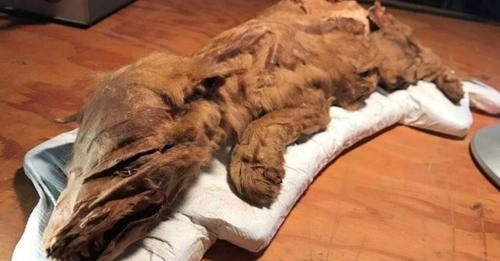Miners Unearth 50,000-Year-Old Caribou Calf, Wolf Pup From Canadian Permafrost
A mummified wolf pup and caribou believed to have walked Earth over 50,000 years ago were discovered with tissue and fur intact — a remarkable find, Canadian authorities say.
The caribou was found at the site of an 80,000-year-old volcanic ash bed and officials believe it’s among the oldest mummified mammal tissue in the world, according to a release.
It was discovered by gold miners, the wolf pub was remarkably well-preserved remains of a caribou calf and wolf pup that each lived more than 50,000 years ago.
The Ice Age specimens were found in the Tr’ondëk Hwëch’in Traditional Territory, a First Nation territory in Yukon.
Officials say the ancient caribou dug up from a site containing an 80,000-year-old volcanic ash bed now stands as one of the oldest examples of mummified mammal tissue in the world.

After miners first discovered the mummified animals in the Klondike region, researchers with the Yukon Paleontology Program recovered and conducted analyses of the remains.
With each still containing hair, skin, and muscle tissue, the experts say the discoveries are extremely rare.
The 50,000-year-old caribou and wolf pup could help to ‘shed light on Yukon’s fascinating Ice Age history and will help us understand how these long-gone creatures lived in the environment they inhabited,’ said Premier Sandy Silver.
Both of the mummies were discovered back in 2016.
The caribou calf was found on Tony Beets’ placer gold mine on Paradise Hill June 3 of that year. Beets are best known from Discovery’s show, Gold Rush.
The mummified wolf pup was found the following month.

While the caribou carcass is missing some parts of its body, with only the front half still intact, the wolf pup was found to be complete, with its head, tail, paws, skin, and hair.
‘We found the caribou and our neighbours, the Favron’s found the wolf pup,’ Beets wrote on Facebook.
‘Such amazing things to be found here under the midnight sun.’

The two Ice Age specimens were unveiled at the Dänojà Zho Cultural Centre last week.
And, they hold special significance to the Tr’ondëk Hwëch’in, upon whose land they were discovered.
‘For Tr’ondëk Hwëch’in, wolf and caribou are very important and interconnected,’ said Tr’ondëk Hwëch’in Chief Roberta Joseph.
‘The caribou has fed and clothed our people for thousands of years. The wolf maintains balance within the natural world, keeping the caribou healthy.’
Both mummified animals will be on display for the rest of the month, before being incorporated into an exhibit at the Yukon Beringia Interpretive Centre in Whitehorse.
‘These specimens will help scientists learn more about the ancient mammal species that roamed Beringia, increasing our knowledge and ability to share the stories of this lost, ancient land,’ said Minister of Tourism and Culture Jeanie Dendys.


